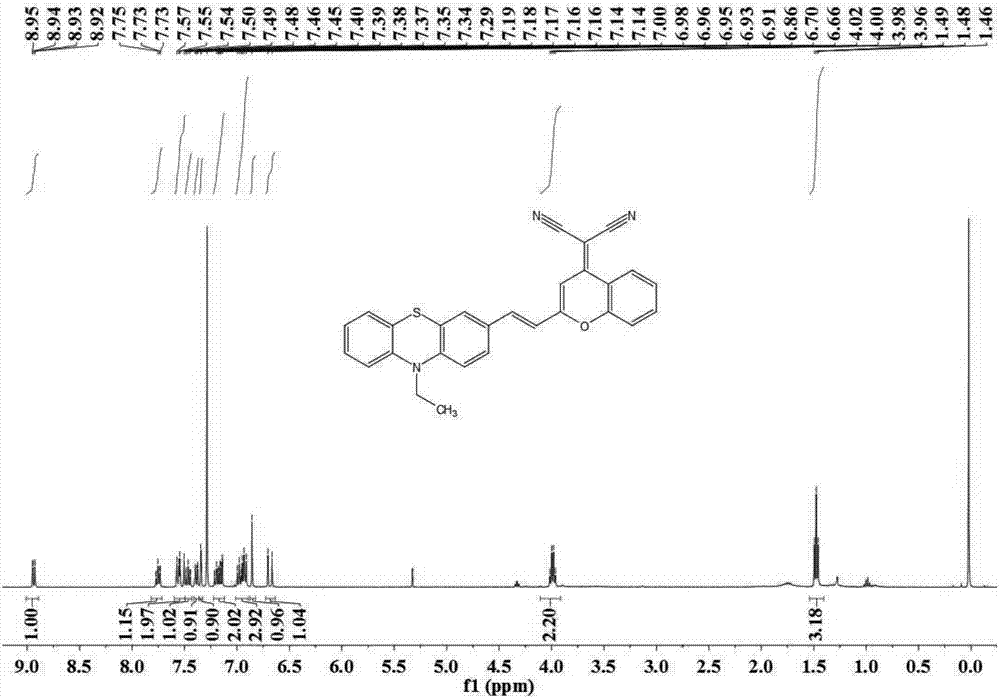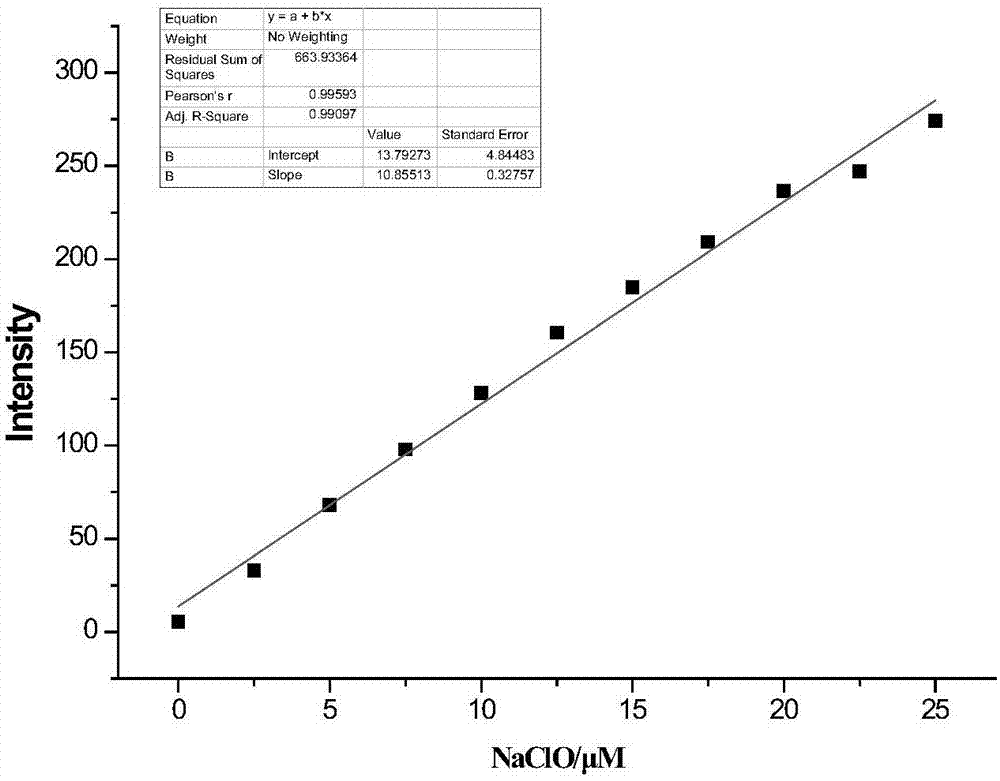Hypochlorous acid fluorescent probe, as well as preparation method and application thereof
A fluorescent probe, hypochlorous acid technology, applied in the field of analytical chemistry, can solve the problems of long reaction time and poor specificity, and achieve the effects of simple post-processing process, rapid detection and simple synthesis
- Summary
- Abstract
- Description
- Claims
- Application Information
AI Technical Summary
Problems solved by technology
Method used
Image
Examples
Embodiment 1
[0036] Example 1 Synthesis of fluorescent probe PZ-HClO.
[0037] (1) Dissolve o-hydroxyacetophenone (10.0 g, 13.5 mmol) in 200 mL of ethyl acetate, and slowly add sodium (8.0 g, 340 mmol) while stirring. React at room temperature for 4 hours. Use a TCL plate to detect the reaction. After the reaction is complete, filter under reduced pressure. The obtained solid is dissolved in 100 mL of water and neutralized with hydrochloric acid until the pH is neutral. Extract with ethyl acetate, dry over anhydrous sodium sulfate, and spin dry the solvent under reduced pressure to obtain a crude product, which is separated with a silica gel column, the silica gel particle size is 200-300 mesh, and the eluent ratio is ethyl acetate / petroleum ether=1: 6. The yield is 80%.
[0038] (2) Compound 1 (6.95 g, 38.9 mmol) was dissolved in 70 mL of acetic acid, sulfuric acid (4.6 mL) was slowly added to the above solution, and heated at 120 °C for 1 h. The reaction was detected with a TCL plate. ...
Embodiment 2
[0043] Example 2 Fluorescence intensity of fluorescent probe PZ-HClO changes with HClO concentration.
[0044] The PZ-HClO hypochlorous acid fluorescent probe prepared in Example 1 was dissolved in N,N-dimethylformamide (DMF) to prepare a 1 mmol / L stock solution. Take 30uL from the stock solution and add it to a 5mL centrifuge tube, dilute to 3 mL with 0.1mol / L, pH=7.5 phosphate buffered saline (PBS) and ethanol at a volume ratio of 1:1, add different concentrations (0 -25 μM) NaClO standard solution (NaClO will spontaneously produce acid-base balance shift in aqueous solution under neutral conditions to produce HClO, the same below), and use 450 nm as the excitation wavelength to measure its fluorescence spectrum. The fluorescence spectrum is as follows: figure 2 shown. Taking the concentration of NaClO as the abscissa and the fluorescence intensity as the ordinate, we can get image 3 , the fluorescence intensity increased significantly with the increase of NaClO concent...
Embodiment 3
[0045] Example 3 Selectivity of fluorescent probe PZ-HClO to different molecules or ions.
[0046] Take 30 μL from the fluorescent probe stock solution in Example 2 and add it to a 5 mL centrifuge tube, add equimolar amounts of sulfhydryl ions (HS - ), sulfide ion (S 2- ), sulfite ion (SO 3 2- ), dibutyl butyl phosphate (DBBP), tert-butyl hydroperoxide (TBHP), nitric oxide (NO), hydrogen peroxide (H 2 o 2 ), nitrite ion (NO 2 - ), nitrate ion (NO 3 2- ), hydroxyl radical (OH . ) and other standard solutions of competing or interfering molecules / ions, another two test tubes were added with an equimolar amount of sodium hypochlorite standard solution and an equal amount of water (blank control), and after 30 minutes, 450 nm was used as the excitation light to detect the fluorescence emission of the solution Spectral changes, results such as Figure 4 shown. Plotting the fluorescence intensities of different competing molecules or ions, such as Figure 5 shown. Depen...
PUM
 Login to View More
Login to View More Abstract
Description
Claims
Application Information
 Login to View More
Login to View More - R&D
- Intellectual Property
- Life Sciences
- Materials
- Tech Scout
- Unparalleled Data Quality
- Higher Quality Content
- 60% Fewer Hallucinations
Browse by: Latest US Patents, China's latest patents, Technical Efficacy Thesaurus, Application Domain, Technology Topic, Popular Technical Reports.
© 2025 PatSnap. All rights reserved.Legal|Privacy policy|Modern Slavery Act Transparency Statement|Sitemap|About US| Contact US: help@patsnap.com



